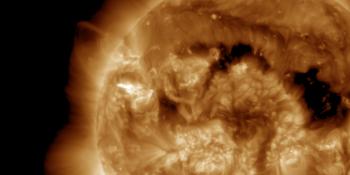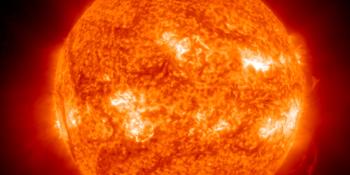Просмотр архива за воскресенье, 4 ноября 2001
Отчет о солнечной активности
Любая солнечная вспышка, упомянутая в этом расчете, имеет масштабирующий коэффициент, применяемый Центром прогнозирования космической погоды (SWPC). Из-за него солнечные вспышки здесь на 42% слабее, чем в научных данных. Из наших архивов этот коэффициент был удален, чтобы показать реальные величины вспышек.
Отчет о солнечно-геофизической активности 2001 Nov 04 2200 UTCПодготовлено NOAA © SWPC и представлено SpaceWeatherLive.com
Совместный отчет USAF/NOAA о солнечной и геофизической активности
Количество SD 308 на уровне 2200Z 04 Nov 2001IA. Анализ активных солнечных регионов и активности от 03 - 2100Z до 04 - 2100Z Solar activity has been high. Region 9684 (N06W27)
produced an X1/3b flare beginning at 1603 UTC, maximum at 1620 UTC,
and ending at 1647 UTC. The event was accompanied by strong radio
bursts, a type II sweep, and a type IV sweep. A CME was observed to
enter the C2 field of view during the flare, with the leading edge
just visible at 1635 UTC. The front edge moved quickly across C2 and
exited somewhere between 1655 UTC and 1705 UTC. Region 9684 has
grown and the leader and trailer spots merged during the past 24
hours, making the region a beta-gamma-delta group. Region 9687
(S20E35) continues to be a complex, beta-gamma group and produced a
few C-class subflares. Region 9682 (N13W64) is still the largest
group on the disk but could only muster a couple of subflares. A 10
degree filament just west of Region 9684 disappeared sometime
between 03/2208 UTC and 04/0629 UTC.
IB. Прогноз солнечной активности
Solar activity is expected to be
moderate to high. M-class events are likely to occur during the next
three days. There is a fair chance for an additional major flare
from Region 9684, especially if new magnetic flux continues to
emerge. Regions 9682 and 9687 also continue to pose a slight threat
for major flare activity.
IIA. Обзор геофизической активности от 03 - 2100Z до 04 - 2100Z
The geomagnetic field was quiet to unsettled during the past 24
hours. A greater than 100 MeV proton event began at 1650 UTC,
shortly after today's X-class flare. Flux levels rose quickly
initially, but began to level off around 1800 UTC, although they are
still climbing slowly. The maximum 100 MeV flux observed so far is
56 pfu at 2035 UTC. A greater than 10 MeV proton event began at 1705
UTC. This event also seems to be leveling off, and the maximum flux
observed so far is 1180 pfu at 2040 UTC.
IIB. Прогноз геофизической активности
The geomagnetic field is
expected to be unsettled to slightly active tomorrow. Major storm
conditions are likely to follow the arrival of a shock from today's
solar event, sometime early on the 2nd day (06 November). The
disturbance is expected to last for about 24 hours, and a decrease
to mostly active conditions should occur on the third day. Today's
greater than 100 MeV proton event is expected to continue for the
next 12 hours. The greater than 10 MeV proton event should continue
tomorrow, and is likely to get an enhancement of flux levels on the
second day with the arrival of the interplanetary shock from today's
solar event.
III. Вероятность события от 05 - Nov до 07 - Nov
| M-класс | 80% | 80% | 80% |
| X-класс | 25% | 25% | 25% |
| Протон | 99% | 80% | 25% |
| PCAF | in progress | ||
IV. Радиоизлучение λ = 10,7см
Наблюдаемый 04 Nov 227 Прогнозируемый 05 Nov-07 Nov 220/215/210 среднее значение за последние 3 месяца 04 Nov 206
V. Геомагнитные индексы
Наблюдаемый Afr/Ap 03 Nov 001/003 По оценкам Afr/Ap 04 Nov 007/008 Прогнозируемый Afr/Ap 05 Nov-07 Nov 015/015-050/050-025/025
VI. Вероятность геомагнитной активности с 05 - Nov до 07 - Nov
| A. Средние широты | |||
|---|---|---|---|
| Активно | 25% | 10% | 20% |
| Слабый шторм | 15% | 15% | 35% |
| Большой шторм | 15% | 75% | 35% |
| B. Высокие широты | |||
|---|---|---|---|
| Активно | 25% | 05% | 15% |
| Слабый шторм | 15% | 10% | 30% |
| Большой шторм | 15% | 80% | 35% |
Все время в UTC
<< Перейти на сегодняшнюю страницу обзора
Последние новости
Последние сообщения с форума
SEEDS is down? 18AR 3959 3Space Weather Memes 653IP cameras for sky surveillance 38Incoming & Unnumbered Active Regions 1399
Больше темПоддержка SpaceWeatherLive.com!
Большое количество посетителей приходят на сайт SpaceWeatherLive, чтобы получить информацию о состоянии Солнца, его активности или возможном появлении полярного сияния. Однако с увеличением трафика растет и стоимость хостинга. Если вы находите наш сайт SpaceWeatherLive.com полезным, пожалуйста, подумайте о пожертвовании на его содержание и поддержку!

Факты о космической погоде
| Последняя X-вспышка | 04/01/2025 | X1.85 |
| Последняя M-вспышка | 09/01/2025 | M1.1 |
| Последняя геомагнитная буря | 04/01/2025 | Kp5 (G1) |
| Безупречные дни | |
|---|---|
| Последний безупречный день | 08/06/2022 |
| Среднемесячное количество солнечных пятен | |
|---|---|
| декабря 2024 | 154.5 +2 |
| января 2025 | 144.5 -10 |
| Последние 30 дней | 151.1 +32.8 |


